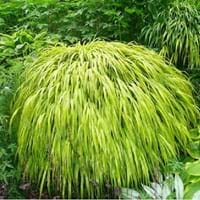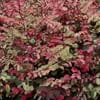Life Span
Perennial
Perennial
Origin
Hybrid origin, Southwestern United States
Japan
Types
Not Available
Benikaze, Nicolas, All Gold, Albostriata
Number of Varieties
Not Available
Habitat
riparian zones, Semi desert, Upland
gardens, Shaded sites, Temperate Regions
USDA Hardiness Zone
8-10
5-9
Sunset Zone
7, 8, 9, 10, 11, 12, 13, 14
1a, 1b, 2a, 2b, 3a, 3b, 4, 5, 6, 7, 8, 9, 10, 11, 12, 13, 14, 15, 16, 17, 18, 19, 20, 21, 22, 23, 24
Habit
Spreading
Clump-Forming
Flower Color
White
Several shades of Green
Flower Color Modifier
Not Available
Bicolor
Fruit Color
creamy white
Non Fruiting Plant
Leaf Color in Spring
Green
Green, Lime Green
Leaf Color in Summer
Green
Light Green
Leaf Color in Fall
Green
Yellow, Red, Orange, Yellow green, Pink, Orange Red
Leaf Color in Winter
Green
Not Available
Leaf Shape
Oblanceolate , Ovate
Long linear and narrow
Plant Season
Spring, Summer, Fall, Winter
Spring, Summer, Fall
Sunlight
Full Sun
Full Sun, Partial Sun, Partial shade
Type of Soil
Clay, Loam, Sand
Loam
The pH of Soil
Acidic, Neutral, Alkaline
Acidic, Neutral
Soil Drainage
Well drained
Well drained
Bloom Time
Spring
Late Summer, Early Fall, Fall
Tolerances
Drought, Dry soil, Heat Tolerance
Not Available
Where to Plant?
Ground, Pot
Container, Ground
How to Plant?
Seedlings
Divison
Plant Maintenance
Medium
Low
Watering Requirements
Needs very little water
Average Water Needs, Requires regular watering
In Summer
Lots of watering
Lots of watering
In Spring
Moderate
Average Water
In Winter
Average Water
Average Water
Soil pH
Acidic, Neutral, Alkaline
Acidic, Neutral
Soil Type
Clay, Loam, Sand
Loam
Soil Drainage Capacity
Well drained
Well drained
Sun Exposure
Full Sun
Full Sun, Partial Sun, Partial shade
Pruning
Cut back old stems to the ground, Remove damaged leaves, Remove dead branches, Remove dead leaves
Remove damaged leaves, Remove dead leaves
Fertilizers
can go long without fertilizers
fertilize in growing season
Pests and Diseases
Pests and diseases free
Pests and diseases free, Red blotch
Plant Tolerance
Dry Conditions, Dry soil, Heat And Humidity
Shade areas
Flowers
Showy
Insignificant
Flower Petal Number
Single
Single
Foliage Texture
Fine
Medium
Foliage Sheen
Glossy
Matte
Attracts
Butterflies
Not Available
Allergy
Unknown
no allergic reactions
Aesthetic Uses
along a porch, deck or patio, Beautification, Ground Cover, Showy Purposes, Wild gardens
Cottage Garden, Showy Purposes, Water gardening
Beauty Benefits
Not Available
No Beauty Benefits
Environmental Uses
Air purification
No fertilizer, pesticides, or herbicides needed
Medicinal Uses
anti-inflammatory, Anti-oxidant, cholesterol-lowering
No Medicinal Use
Part of Plant Used
Twigs
Not Available
Other Uses
Can be made into a herbal tea
Not Available
Used As Indoor Plant
No
No
Used As Outdoor Plant
Yes
Yes
Garden Design
Groundcover
Container, Edging, Mixed Border, Rock Garden / Wall
Botanical Name
BACCHARIS 'Centennial'
HAKONECHLOA macra
Common Name
desert broom , broom baccharis , greasewood
Hakone Grass
In Hindi
desert broom
hakone grass
In German
Wüste Besen
Hakone Gras
In French
desert broom
Hakone herbe
In Spanish
escoba del desierto
hierba Hakone
In Greek
desert broom
Hakone γρασίδι
In Portuguese
vassoura do deserto
Hakone grama
In Polish
desert broom
Hakone trawa
In Latin
desert broom
Hakone herba
Phylum
Magnoliophyta
Magnoliophyta
Class
Magnoliopsida
Liliopsida
Order
Asterales
Cyperales
Family
Asteraceae
Poaceae
Genus
Baccharis
Hakonechloa
Clade
Angiosperms, Asterids, Eudicots
Angiosperms, Commelinids, Monocots
Tribe
Astereae
Not Available
Subfamily
Not Available
Not Available
Number of Species
Not Available
Not Available
Season and Care of Desert Broom and Hakone Grass
Season and care of Desert Broom and Hakone Grass is important to know. While considering everything about Desert Broom and Hakone Grass Care, growing season is an essential factor. Desert Broom season is Spring, Summer, Fall and Winter and Hakone Grass season is Spring, Summer, Fall and Winter. The type of soil for Desert Broom is Clay, Loam, Sand and for Hakone Grass is Loam while the PH of soil for Desert Broom is Acidic, Neutral, Alkaline and for Hakone Grass is Acidic, Neutral.
Desert Broom and Hakone Grass Physical Information
Desert Broom and Hakone Grass physical information is very important for comparison. Desert Broom height is 60.00 cm and width 150.00 cm whereas Hakone Grass height is 30.50 cm and width 61.00 cm. The color specification of Desert Broom and Hakone Grass are as follows:
Desert Broom flower color: White
Desert Broom leaf color: Green
Hakone Grass flower color: Several shades of Green
- Hakone Grass leaf color: Green and Lime Green
Care of Desert Broom and Hakone Grass
Care of Desert Broom and Hakone Grass include pruning, fertilizers, watering etc. Desert Broom pruning is done Cut back old stems to the ground, Remove damaged leaves, Remove dead branches and Remove dead leaves and Hakone Grass pruning is done Remove damaged leaves and Remove dead leaves. In summer Desert Broom needs Lots of watering and in winter, it needs Average Water. Whereas, in summer Hakone Grass needs Lots of watering and in winter, it needs Average Water.





